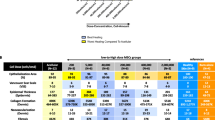Abstract
Regeneration of deep burn wounds after transplantation of allogenic and autogenic fibroblast-like bone marrow mesenchymal stem cells and embryonic fibroblasts on burn surface was studied in 40 Wistar rats. Transplantation of allogenic and autogenic fibroblast-like bone marrow mesenchymal stem cells and transplantation of embryonic fibroblasts decreased cell infiltration of the wound and accelerated the formation of new vessels and granulation tissue in the wound in comparison with the control (burn wounds without cell transplantation). Regeneration processes were most active after transplantation of fibroblast-like bone marrow mesenchymal stem cells, in particular, autogenic cells, which was confirmed by more rapid decrease in burn surface area. Wound healing after transplantation of fibroblast-like bone marrow mesenchymal cells and embryonic fibroblasts was associated with long functioning of transplanted cells (as was shown by staining for β-galactosidase, the cells were transfected with an adenovirus vector carrying the marker gene). It is hypothesized that more rapid regeneration of burn wounds after transplantation of fibroblast-like bone marrow mesenchymal stem cells was due to low differentiation of these cells in comparison with embryonic fibroblasts.
Similar content being viewed by others
REFERENCES
E. G. Kolokol'chikova, L. I. Budkevich, A. E. Bobrovnikov, et al., Byull. Eksp. Biol. Med., 131, No. 1, 107-111 (2001).
M. F. Rasulov, A. M. Khadzhibaev, and M. D. Urazmetova, Med. Zh. Uzbekistana, No. 5-6, 87-88 (2001).
D. S. Sarkisov, A. A. Alekseev, E. V. Glushchenko, et al., Vestn. Rossiisk. Akad. Med. Nauk, No. 6, 6-11 (1996).
V. I. Shumakov, M. F. Rasulov, M. E. Krasheninnikov, et al., Vestn. Transplantol. Iskusstv. Organov, No. 4, 7-11 (2002).
H. Goto, F. D. Shuler, C. Lamsam, et al., J. Bone Joint Sur. Am., 81, No. 7, 918-925 (1999).
R. Gruber, C. Mayer, W. Schulz, et al., Cytokine, 12, No. 11, 1630-1638 (2000).
M. K. Majumdar, V. Banks, D. P. Peluso, and E. A. Morris, J. Cell. Physiol., 185, No. 1, 98-106 (2000).
M. F. Pittenger, A. M. Mackay, S. C. Beck, et al., Science, 284, 143-147 (1999).
B. Seshi, S. Kumar, and D. Sellers, Blood Cells Mol. Dis., 26, No. 3, 234-246 (2000).
S. Teramoto, H. Ito, and Y. Ouchi, Thromb. Res., 93, No. 1, 35-42 (1999).
Author information
Authors and Affiliations
Corresponding author
Rights and permissions
About this article
Cite this article
Shumakov, V.I., Onishchenko, N.A., Rasulov, M.F. et al. Mesenchymal Bone Marrow Stem Cells More Effectively Stimulate Regeneration of Deep Burn Wounds than Embryonic Fibroblasts. Bulletin of Experimental Biology and Medicine 136, 192–195 (2003). https://doi.org/10.1023/A:1026387411627
Issue Date:
DOI: https://doi.org/10.1023/A:1026387411627




